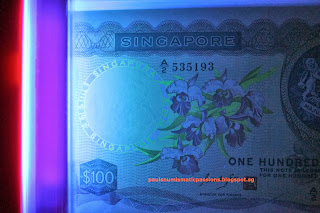Today I came up with a simple but effective 3 step due diligence process on purchasing currency notes. I experienced the awful experience of having bought a washed note before from a flea market dealer and paid a hefty price for the lesson. As such I'm eager to share some simple tips on how to see if your note is genuine and whether it has been adversely processed or damaged before.
I also endeavour to check all the notes that I have displayed on this blog to ensure a pleasant and valued numismatic experience for all fellow collectors and newbies who are keen to keep a part of our nation's history. For anyone who would like me to help verify your old notes you can contact me on paulsnumismaticpassions@gmail.com for a free verification service. Sharing the passion :)
Do enjoy the read!
Step 1: Physical Examination
- Proper Due Diligence
Always request to physically inspect the note before purchase. Also insist to have the note removed from its lamination especially if the note is of significant value. Only notes that have been graded by 3rd party professional graders like PMG are fine to be kept in their certified pouched folder which preserves the note's value. Below is an example of a graded note by PMG based in the USA. You can trust the grade and authenticity of the note if it's been certified by a 3rd party grader. Notes that have been washed, damaged etc will be indicated by them as such.
 |
| Certified note by PMG, as having grade of 55 and exceptional paper quality or EPQ indicated on the top right. |
- Visual inspection.
The colours on an original and unprocessed note should look vibrant and lively. The paper should also look whole and in a solid piece.
 |
| Example of a washed note. notice the colours especially on the orchids are dull. the paper also looks limp and soft. |
- Touch Inspection.
Feel whether the note is 'limp'. Limp would mean that the note doesnt feel crisp like a new note. Take a new paper dollar note and feel it. It should feel crisp, firm and have a nice whole texture. When a note has been washed it would feel limp and 'thinned'.
 |
| Example of a limp and washed note |
 |
| Example of a crisp and original condition note. |
Step 2: Smell Examination
- Take the note and smell it. It shouldnt smell of any strong chemical smell. For eg. a note that has been washed with chlorox would have a strong bleach or chemical smell.
Step 3: UV examination
- You can use UV light to see if the note has been washed. In a dark place shine your UV light on the note to see if there are any blotches that are obvious tell-tale signs that the note has been washed.
 |
| Notice the top middle part of the note. There are blotches which show that the note has been washed by chemicals before to lend an appearance of a higher grade. |
 |
| This is how an original note should look like. Notice the clarity of the note under UV light without any blotches. |
 |
| Notice how the security features are glowing clearly. No visible blotches on the note with perfect clarity. This note was certified with exceptional paper quality by PMG. |

Hi Paul, I have 100 runs Orchid $1 GKS signature if you are interested. All GEM UNC.
ReplyDeleteYou can contact me at 98558652 for easier communication. Thank you
ReplyDeleteAt Knowledgetics Research, our team of business due diligence experts offers a range of services tailored to meet your specific needs. Whether you require financial analysis, market research, or competitive intelligence, we deliver customized solutions to support your decision-making process. Rely on our expertise to minimize risks and maximize opportunities in your business ventures.
ReplyDeleteWell explained! Due diligence is a crucial step in any major business decision, as it helps uncover risks and validate financial and legal information. Engaging professional due diligence services can make all the difference in ensuring informed, confident decisions. Thanks for the valuable insights!
ReplyDelete